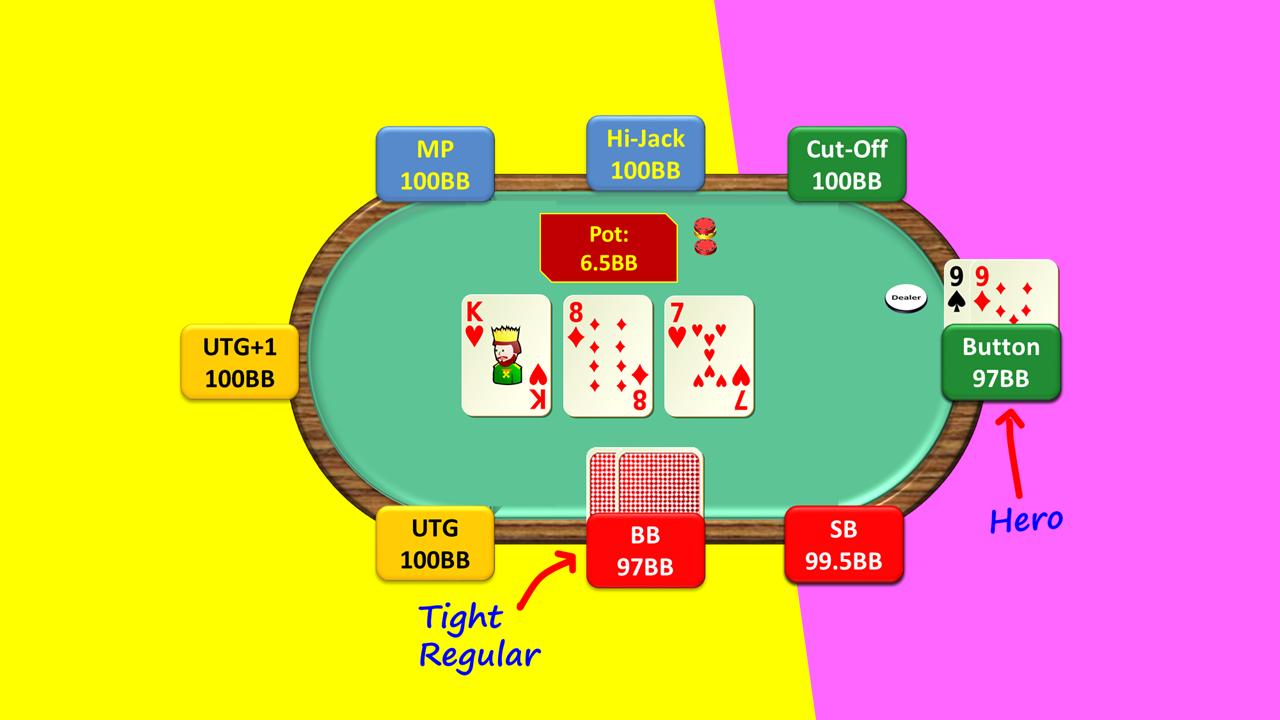Hero is In Position/With the Lead/Wet Board
When I am playing against passive players, I prefer a wet board. On a wet board, some players can have a betting action that puts them on one hand exactly. This is one of those hands.

When villain just calls in the BB, I would put him on the range below.
Villain’s Estimated Range (using Flopzilla)

I would remove AA and AK from his range, as I think that he would 3-bet with these types of hands.
Flop: Villain Donk Bets (Small)
When a tight player donk bets small on this flop, I would put him on one hand. That hand is a draw. Sometimes, players put in a small donk bet with weak made hands. However, I can’t see a tight player doing this with QQ-99 on a king-high flop.
Tight players don’t play many drawing hands. Their range is heavily biased towards playing pocket pairs.
In the range that, I have estimated for villain’s hand, the only draw hand is a single combo, which is A♥Q♥. He can’t have the A♥K♥ because the K♥ is on the board.
If I have overestimated how tight villain is, he could have called with a couple of other suited heart hands, such as A♥J♥ and A♥T♥.
Unlike on a dry board, a small donk bet makes it improbable that he has a monster and is trying to trick you into raisng. The reason is because he would be scared that you would just call a small bet on a draw heavy board.
Should You Call or Raise?
Folding isn’t an option because, if your read is correct, you have the best hand at the moment.
Calling
You can call this flop bet and hope that villain doesn’t hit one of his outs on the turn. If he misses his outs and checks, you can then put in a big bet on the turn.
If he hits one of his outs, the hand ends for you. You shouldn’t put any more money into the pot.
If villain has A♥Q♥, he is a favourite to win the hand by the river. However, if his hand misses the turn card, he is an underdog to hit one of his outs on the river.
Raising
Raising is only an option, if you don’t think that your opponent would put in a big re-raise with the nut flush draw and 2 overcards. If he re-raises all in, you are an underdog against this hand. Villain has 15 outs. There are 9 hearts, 3 aces and 3 queens left in the deck.
Therefore, you should raise this to the size of the pot. If you get re-raised, you are done with the hand. He has acted weak. Consequently, if he shows any aggression in the hand, you should fold.
Let’s say that the betting has gone as follows.
Pre-flop
Hero 100BB (Button): Raises 3BB
Villain 99BB (BB): Calls 2BB
Flop (Pot = 6.5BB)
Villain 97BB (BB): Bets 2BB
Hero 97BB (Button): Raises 10BB
Villain 95BB (BB): Shoves 95BB
At this point, hero has 87BB in his stack and the pot is 113.5BB.
Can hero call?
We have to put the numbers into the Fold Equity Calculator.

The minus number for “Percent Folds to Break Even” means that hero can call, but it is only just a call.
In addition, you have to be 100% right about your read that villain is on a flush draw with overcards.
The obvious concern is that villain could have a set and have tricked you with the small donk bet. As I have said, it is unlikely that a tight player would try and trick you with a small donk bet on such a draw-heavy board. Most tight villains would be too scared that you would just call this bet and the turn card would put a third heart on the board.
Although I think this is unlikely that a tight player would play a set this way, you don’t have to be wrong very often for calling a shove on the flop to be wrong.
If you have just 2% less equity than shown in the calculator, it is wrong to call a shove.
Does that mean that it is wrong to raise? It depends on another read on villain.
Raising the small donk bet is best, if you believe that villain will just call the raise or just re-raise by a small amount.
Villain is an underdog to hit his outs on the turn. Therefore, if you can build a big pot before the turn and the turn card misses villain’s hand, you can put a big bet in, which will get villain to fold his hand on the turn.
However, for you to put a big turn bet in, you have to have a decent size stack left. With 15 outs, we can calculate (using the Rule of 2.2) that villain is slightly better than a 2/1 underdog on the river.
This means that he can call a pot-sized bet. The good news is that villain probably doesn’t know that a queen is an out. He probably thinks that you have a king. Therefore, villain will be counting just 12 outs.
However, you would want to overbet the pot on the turn, just to make sure that villain has the wrong odds to call.
Whether you call or raise, if any of villain’s outs hit the board, you are done with your hand.
Conclusion
This is a useful reference hand to memorise. This is a situation that is more likely to occur against calling stations and aggressive players. These types of players are more likely to shove on the flop, if you re-raise.
So, if you see a player shove on the flop with a draw, you should note that down. If you see that a player didn’t shove on the flop, when he had an opportunity to do so, you should also note this down.
